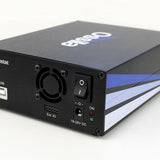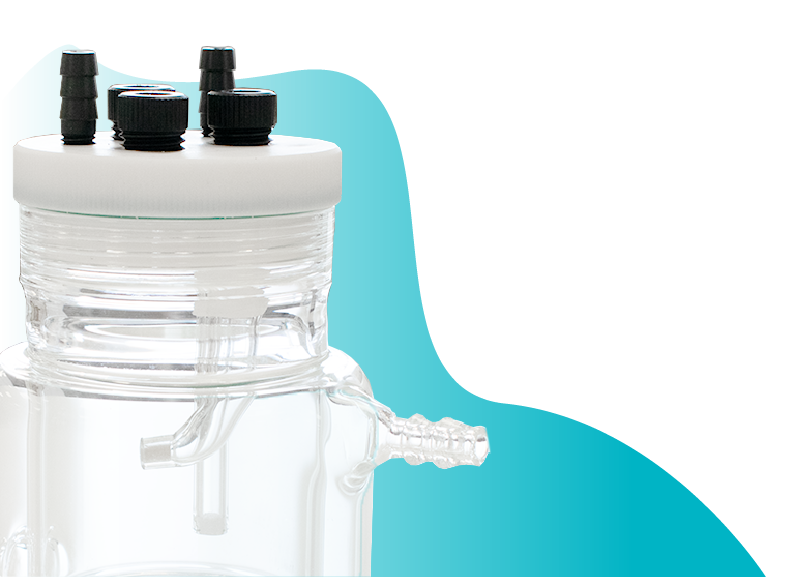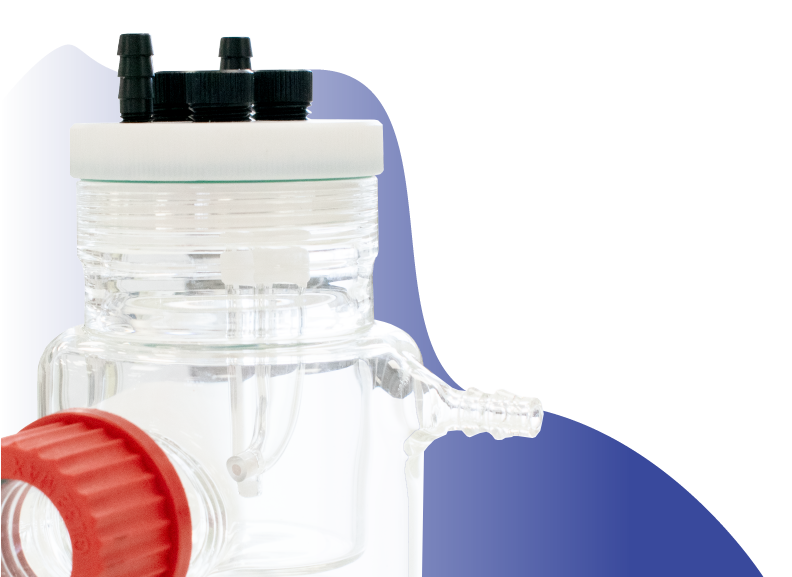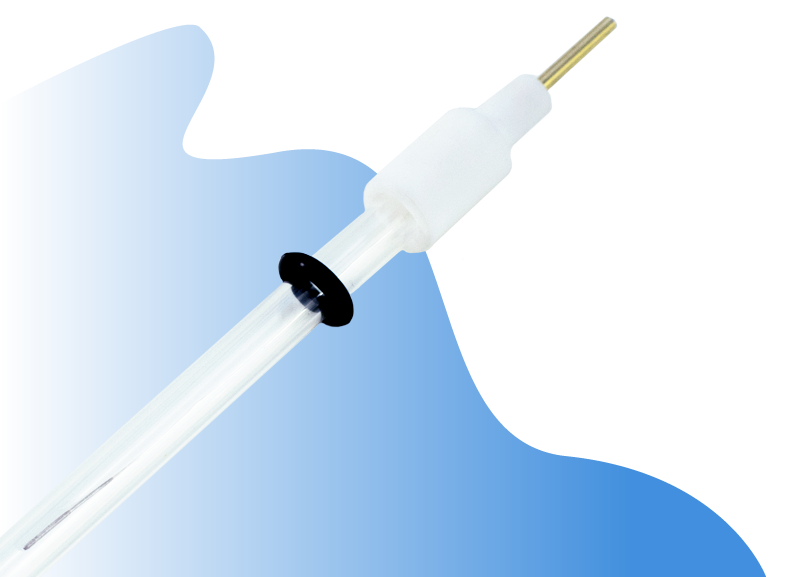Potentiostat Circuit Diagram and Working Principles

A potentiostat is a voltage source that is able to vary its output potential in response to changes in the resistance across a circuit. In electrochemistry experiments, potentiostats are able to supply more or less current so that the potential across an electrochemically active cell remains constant as per Ohm’s Law.
Electrochemical techniques like cyclic voltammetry, linear sweep voltammetry, and other types of voltammetry require a potentiostat to measure redox events taking place in a solution.
A typical experimental set up consists of a potentiostat connected to a three electrode cell by a working electrode, counter electrode, and reference electrode. Potentiostats control the potential between the working and reference electrodes and measure the current between the working and counter electrodes.
Analysis of the data recorded by a potentiostat reveals various intrinsic electrochemical properties of the material, depending which method is used. Using techniques like cyclic voltammetry, potentiostats can be used to find the redox potential of materials, determine the reversibility of a reaction, provide a quantitative description of electrochemical reversibility, and determine the energy levels of semiconducting polymers.
Contents
- Potentiostat circuit design
- Electrochemical cell set-up
- Potentiostat specifications explained
- Maximum current
- Current ranges
- Current measurement accuracy
- Current measurement resolution
- Potential range
- Potential compliance
- Applied potential accuracy
- Applied potential resolution
- Ossila Potentiostat specifications
Potentiostats vs. galvanostats
Potentiostats are often discussed alongside similar electrochemical devices such as galvanostats (also known as amperostats). Galvanostats operate on similar principles to potentiostats but maintain a constant current across the cell rather than a constant potential. The most common application for galvanostats is as battery chargers.
Potentiostat Circuit Design
A simplified potentiostat circuit diagram is shown in figure 1. It consists of several key sections, each of which is detailed below:
- signal generator
- feedback amplifier
- control amplifier
- current amplifier
- signal converter
Signal generator
The signal generator determines the applied voltage resolution of the potentiostat. It outputs variable DC (direct current) voltages via a digital-to-analogue converter (DAC), which converts a computer-generated signal into a voltage. This allows the user to be able to accurately control the output voltage of the potentiostat via a computer.
Feedback amplifier
The voltage feedback amplifier is perhaps the most important part of the potentiostat circuit. It measures the voltage between the working reference and the reference electrode, passing it to the signal converter to be sent to the computer. However, it also feeds this voltage to the negative terminal of the control amplifier. This enables the potentiostat, via the control amplifier, to keep the set voltage stable relative to the reference electrode.
It is important that the feedback amplifier does not overload the electrode voltage and disturb the electrochemical reaction, so a high input impedance with very low input current (pA) is used. The feedback amplifier also needs to be fast enough to allow the potentiostat to keep up with the rapid changes that can occur in electrochemical reactions and provide the feedback voltage to the output amplifier.
Control amplifier
The control amplifier takes the voltage output of the signal generator and the feedback amplifier and outputs the voltage that will be passed between the working and counter electrodes. This is where the potentiostat accounts for any loss of voltage due to electrochemical reactions taking place in the cell. By using the output of the feedback amplifier as an input of the control amplifier, the signal is increased or decreased, allowing the device to keep the voltage between the working and reference electrodes stable.
The specifications of the control amplifier will determine the maximum voltage and current that the potentiostat system can output.
Current amplifier and current ranges
This section of the circuit is for measuring the current passing through the working electrode and counter electrode. It consists of a single resistor or a set of resistors (the current ranges) and an amplifier. Each resistor corresponds to a different current range and can be toggled on or off to select the desired current range. Therefore, the number and resistances of these resistors will determine the currents that can be measured by a potentiostat.
When the current passes through a resistor it generates a voltage. The voltage is increased by the amplifier according to the selected current range and passed into the signal converter where it is converted to a current measurement.
Signal converter
The signal converter uses an analogue-to-digital converter (ADC) to convert the output of the voltage feedback amplifier and the current amplifier into a digital signal that can be interpreted by a computer connected to the potentiostat.
Potentiostat

Electrochemical Cell Set-Up
Potentiostats can be used to control two, three or four electrode configurations (and as discussed above, multi-channel bipotentiostats or polypotentiostats can control rotating ring-disk electrode systems).
The three electrode set-up is by far the most common and consists of a working electrode, a counter electrode, and a reference electrode. Each of these three functions also exists in a two electrode cell, only a single interface both provides a reference potential and allows current to flow across the cell. The primary issue with such a set-up is that it renders it impossible to accurately control the potential at the working electrode.
Working electrode

The working electrode is the primary electrode in an electrochemical system. It is where the applied voltage enters the system, and where most electrochemical reactions and electron transfer take place.
Measurements of potential and current in an electrochemical system involve the working electrode for both two and three-electrode systems. In two-electrode systems the potential and current are measured between the working and counter electrodes. In three-electrode systems, a potentiostat measures the potential between the working and reference electrodes whilst the current is measured between the working and counter electrodes.
Platinum is the most common material used for working electrodes due to its electrochemical stability and ease of fabrication. Other commonly used materials include gold, carbon, and mercury.
Reference electrode

By having a stable, known, and well-defined electrochemical potential, reference electrodes provide a constant for an electrochemical measurement.
They are used in a three-electrode system to maintain a stable potential against which the potentiostat measures and controls the working and counter electrodes. This is achieved using materials with well-defined electrochemical potentials, typically chemically separated from the reactions occurring during the measurement. When a voltammogram of such a system is plotted, the potential is that which is measured between the working and reference electrodes.
In an ideal electrochemical system, zero current will flow through the reference electrode, enabling accurate measurements and control of the potential at the working electrode. This is achieved by the reference electrode having a very low impedance, ideally zero.
Counter electrode
Counter electrodes, also known as auxiliary electrodes, complete the circuit of a two or three-electrode system. As with the working electrode, platinum is the most common material used for counter electrodes due to its electrochemical and mechanical stability, and high electrical conductivity.
In two-electrode systems, the counter electrode is also used as the reference electrode. This requires it to have a much greater surface area than the working electrode to ensure that reaction kinetics at the working electrode are not inhibited by those at the counter electrode.
In three-electrode systems, the current is measured between the working and counter electrodes. The potential is not measured here, but is adjusted by the potentiostat to balance the electrochemical reactions occurring. Instead, the potential is measured between the working and reference electrodes, ideally with zero current passed between the counter and reference electrodes.
Sometimes the counter electrode is separated from the working electrode in a similar manner to the reference electrode to reduce the influence of reactions taking place at the counter electrode on those at the working electrode.
Potentiostat Specifications Explained
Maximum current
The maximum current is the highest electrical current that can be measured by a potentiostat. It applies for both positive and negative currents and as such is represented with a plus/minus symbol. If a measured current is outside of this range, a potentiostat will turn off the output potential to prevent damaging the unit.
Current ranges
To achieve a consistent level of accuracy and precision for current measurements at both milliamps and nanoamps, current measurements are split into a set of ranges. These ranges are typically separated by an order of magnitude, and whilst one range can usually measure the currents encompassed by the range below it, the accuracy and precision of the measurement will be worse.
Measurement of current works by measuring the voltage across a known resistor when the current passes through it. Therefore, to measure current at different orders of magnitude a series of resistors are used, with lower currents passed through higher resistance resistors.
The accuracy, precision, noise, and resolution of each range typically follows the same order of magnitude differences as the currents, as these are most heavily influenced by the measurement of the voltage, rather than the resistors used.
Current measurement accuracy
The current measurement accuracy is the maximum amount that a measured current value can vary from the actual current value. It is important to note that most measurements will vary by less than this amount. This value scales with the order of magnitude of the current ranges.
Current measurement resolution
The current measurement resolution is the smallest change in current that can be measured by a potentiostat. This value scales with the order of magnitude of the current ranges.
Potential range
The potential range is the potential window that can be applied and measured by a potentiostat between the working and reference electrodes. This typically applies for both positive and negative potential, and in such a case is represented with a plus/minus symbol.
Potential compliance
The potential compliance is the maximum limit for the potential that a potentiostat is capable of outputting between the working and counter electrodes. As with the potential range, it applies for both positive and negative potentials and as such is represented with a plus/minus symbol.
Electrochemical reactions that occur during a measurement often result in decreased potential at the reference electrode. This means that a greater output potential must be applied to the cell to achieve the desired potential.
It is important to note the distinction between the potential range and the potential compliance. Potential range is the applied and measured potential between the working and reference electrodes, whilst the potential compliance is the absolute maximum potential that can be applied between the working and counter electrodes.
Applied potential accuracy
The applied potential accuracy is the maximum amount the output potential of a potentiostat can vary from the set potential. Specifically, this refers to the potential between the working and reference electrodes. It is represented as a plus/minus offset.
Applied potential resolution
As a potentiostat uses digital signals to determine the potential to output, any change in potential will appear as a step, and a scan profile a series of steps over time, as shown in figure 4. The applied potential resolution determines how small these steps can be, as it is the smallest change in potential that can be output by a potentiostat.
Ossila Potentiostat Specifications
Potential specifications
| Potential range | ±7.5 V |
|---|---|
| Potential compliance | ±10 V |
| Applied potential accuracy | ±10 mV offset |
| Applied potential resolution | 333 µV |

Current specifications
| Maximum Current | Accuracy | Resolution |
|---|---|---|
| ± 150 mA | ± 200 µA | 50 µA |
| ± 20 mA | ± 20 µA | 5 μA |
| ± 2 mA | ± 2 µA | 500 nA |
| ± 200 µA | ± 200 nA | 50 nA |
| ± 20 µA | ± 20 nA | 5 nA |
Other specifications
| Communication | USB-B |
|---|---|
| Overall Dimensions | Width: 125 mm Height: 55 mm Depth: 175 mm |
| Weight | 600 g |
Potentiostat

Learn More
 Cyclic Voltammetry Applications and Uses
Cyclic Voltammetry Applications and Uses
Cyclic voltammetry is a versatile electrochemical method with a range of different applications.
Read more... Getting Started with the Ossila Potentiostat
Getting Started with the Ossila Potentiostat
The Ossila Potentiostat has been designed to make it quick and easy to perform electrochemistry.
Read more...Contributing Authors
Written by
Software Engineer
R&D Engineer


